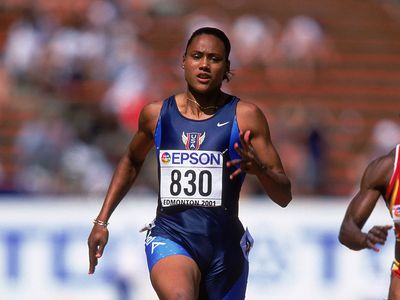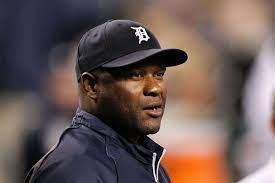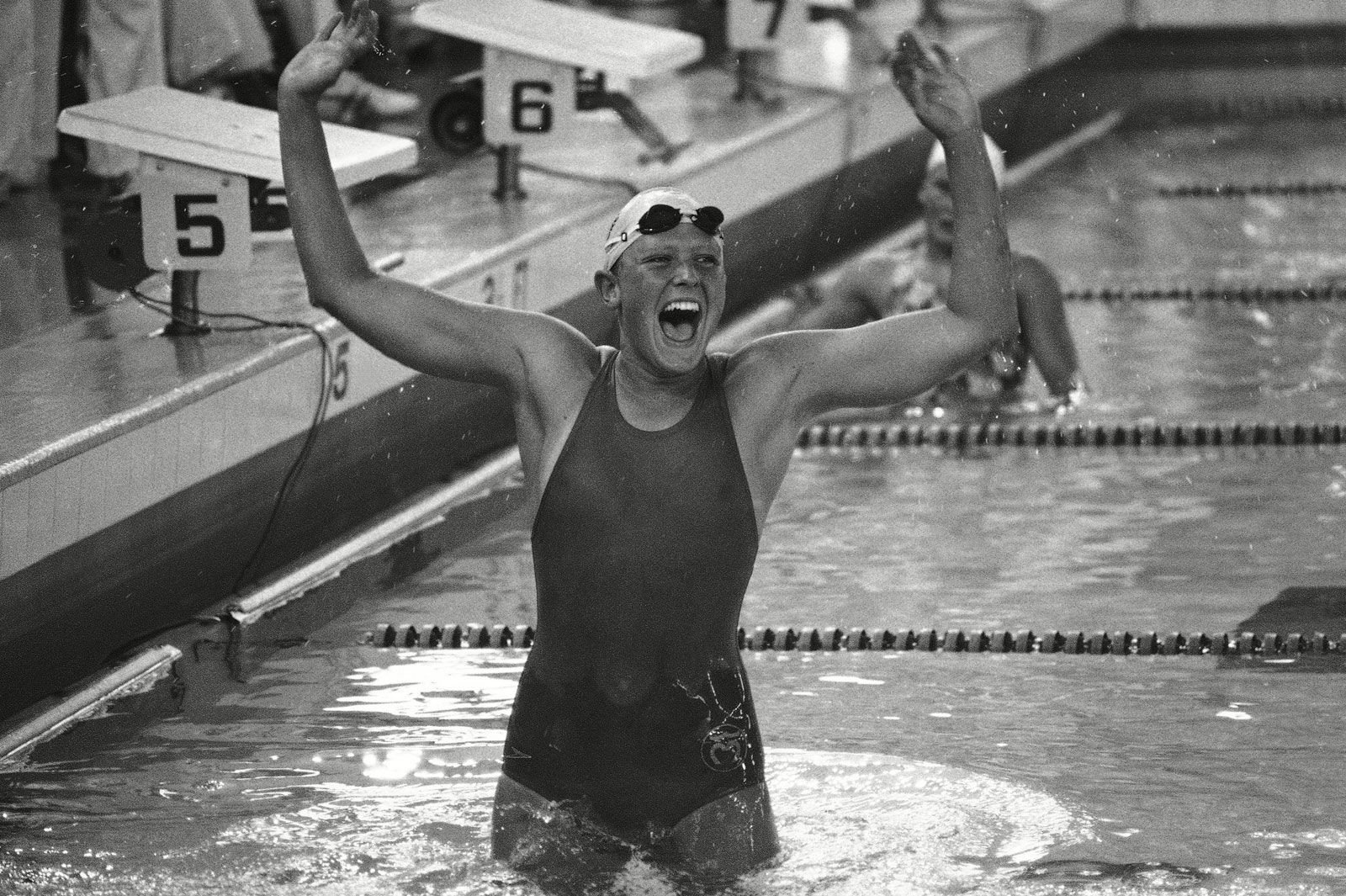The Marion Jones story is one of the saddest sagas in sports history.
The fastest woman on the planet for more than a decade, Jones was a force of nature. National high school sprint champion at 16 and winner of California state prep titles in both basketball and track, Jones was one of the most accomplished athletes of all time.
She was an NCAA hoops champion, world record holder and Olympic champion. She then very publicly fell from grace to shame in one of the ugliest PED scandals of the past quarter-century.
Unlike the dopers that sullied Major League Baseball and suffered no consequences, Marion Jones paid a dear price for her misdeeds.
Born in Los Angeles October 12, 1975, Marion Lois Jones is the only child of George Jones and his Belizean wife, Marion. Her parents split when she was young and Jones’s mother remarried retired postal worker Ira Toler, who became a stay-at-home dad to young Marion Jones.
Following Tolar’s unexpected death in 1987, Jones turned to sports as an outlet for her grief. Marion and her older half-brother, Albert Kelly, moved with their mother several times so Marion could compete on prominent youth teams. By 12, she was competing internationally and, as a high schooler, was dominating on the track as well as the basketball court.
Jones spent her freshman and sophomore years at Rio Mesa High School in Oxnard, California – the Strawberry Capital of the World. After being named Track & Field News 1991 Athlete of the Year following her sophomore year, she moved to nearby Thousand Oaks.
At Thousand Oaks High School, alma mater of actor Kurt Russell, Jones worked with Elliott Mason, previous trainer of Olympic star Evelyn Ashford. Jones set two national high school track records and won nine California state titles during her prep career, and was named national high school girls track and field athlete of the year an unprecedented three times.
She was also a standout in basketball, leading Thousand Oaks to a 60-4 record , once scoring 48 points in a game. After averaging nearly 23 points and 15 rebounds per game as a senior, Jones was named 1993 California Division I High School Player of the Year, and accepted a basketball scholarship to the University of North Carolina.
The 5’10” Jones earned the North Carolina starting point guard job as a freshman. She led the Tar Heels to a 33-2 record and 1994 NCAA championship while averaging more than 14 points per game.
Jones set her sights on training for the 1996 Olympic track team, but a broken bone in her foot suffered while practicing with the USA basketball team a year earlier kept her out of the Atlanta Games.
She returned to basketball and was named MVP of the 1997 ACC Tournament. In three seasons at UNC, Jones scored 1,716 points and led the Heels to a 92-10 record. North Carolina coach Sylvia Hatchell called Jones one of the most coachable athletes she had worked with in her three-decades of coaching.
After graduating North Carolina in 1997, Jones exploded onto the international track scene, capturing gold medals in the 100m and 4 x 100m relay at that year’s World Championships. In 1998, she won the 100m and 200m sprints at the Goodwill Games and Continental Cup meets.
After defending her title in the 100m and adding a bronze in the long jump at the 1999 World Championships in Seville, Jones became the biggest name in women’s track. In the run-up to the 2000 Sydney Olympics, the 24-year-old Jones was a media darling, appearing on the covers of Time, Newsweek and Sports Illustrated.
The fastest woman in the world dominated the 2000 Summer Olympics. She won three gold medals, including running 10.75 in the 100m to claim the second-largest margin of victory in the history of the event. After earning bronze in the long jump and 4 x 100 relay, Jones became the first woman ever to win five medals in a single Olympics.
At the same time Jones was making history, her husband, shot-putter C.J. Hunter, was being banned from the Games after testing positive for performance-enhancing drugs [PEDs] in Sydney. Few fingers pointed at Jones, although she and her husband used the same trainer [the couple divorced in 2002].
Jones lost her first 100m race in six years at the 2001 World Championships, but won gold in the 200 and 4 x 100 relay. She was undefeated in the 2002 season, then took much of 2003 off due to the birth of her son [whom she had with then-boyfriend Tim Montgomery, a world class sprinter].
Jones did not return to form for the 2004 Athens Olympics, finishing fifth in the long jump and missing a baton exchange in the 4 x 100 relay that cost the Americans a chance for a medal.
Throughout her athletic career, Jones had been accused of taking PEDs. As a high schooler at Thousand Oaks in 1992, she failed to show for a random drug test and was defended by Johnnie Cochran [who defended O.J. Simpson in his infamous murder trial three years later], who successfully argued on appeal that neither Jones nor her coach had received notification of the test.
In 2004, ex-husband C.J. Hunter testified before a federal grand jury that Jones’s use of banned drugs began well before Sydney.
Victor Conte, the founder of BALCO [the lab that supplied Barry Bonds with steroids that tainted some of the most hallowed records in major league baseball history] said in an interview on ABC’s 20/20 that he had personally given Jones four different PEDs before, during and after the 2000 Sydney Olympic Games.
Former boyfriend Tim Montgomery was stripped of a world record and issued a two-year suspension for doping. Jones’s former coach, Trevor Graham, was implicated and banned from USOC workout facilities.
Like cyclist Lance Armstrong, Jones vehemently denied ever being involved with PEDs in any way. In October 2007, she admitted lying to federal agents under oath about her use of steroids prior to the 2000 Olympics and pleaded guilty. She served six months in federal prison.
The IOC stripped Jones of all five Olympic medals, banned her from attending the 2008 Beijing Olympics in any capacity, and disqualified her fifth-place finish in the long jump at the 2004 Athens Games.
Jones voluntarily returned her Olympic medals and apologized to family, friends and fans. Once the darling of Team USA, she lost her livelihood. At her hearing, Jones’s attorneys delivered the following statement:
“She has been cast from American hero to national disgrace. This part of her story will forever be one of personal tragedy.
To be clear, the public scorn, from a nation that once adored her, and her fall from grace have been severe punishments. She has suffered enormous personal shame, anguish and embarrassment. She has been stripped of her gold medals, her accomplishments, her wealth, and her public standing.”
Marion Jones is the fourth American athlete in history to have an Olympic medal taken away by the IOC, and the third for doping. Jim Thorpe had his 1912 Olympic pentathlon and decathlon golds stripped when it was revealed he earned $ 25 a week playing minor league baseball.
The IOC reinstated Thorpe in 1982 and returned the medals to his children the following year.
In 2010, the Tulsa Shock signed Jones to a WNBA contract. She played in all of the team’s games in 2010, but was cut 15 games into the 2011 to make space for Abi Olajuwon, daughter of NBA hall-of-fame center, Hakeem Olajuwon. Jones was grateful for the WNBA opportunity and was thankful it offered “a platform to demonstrate to people, especially our youth, that if you have faith, life is full of second chances.”









